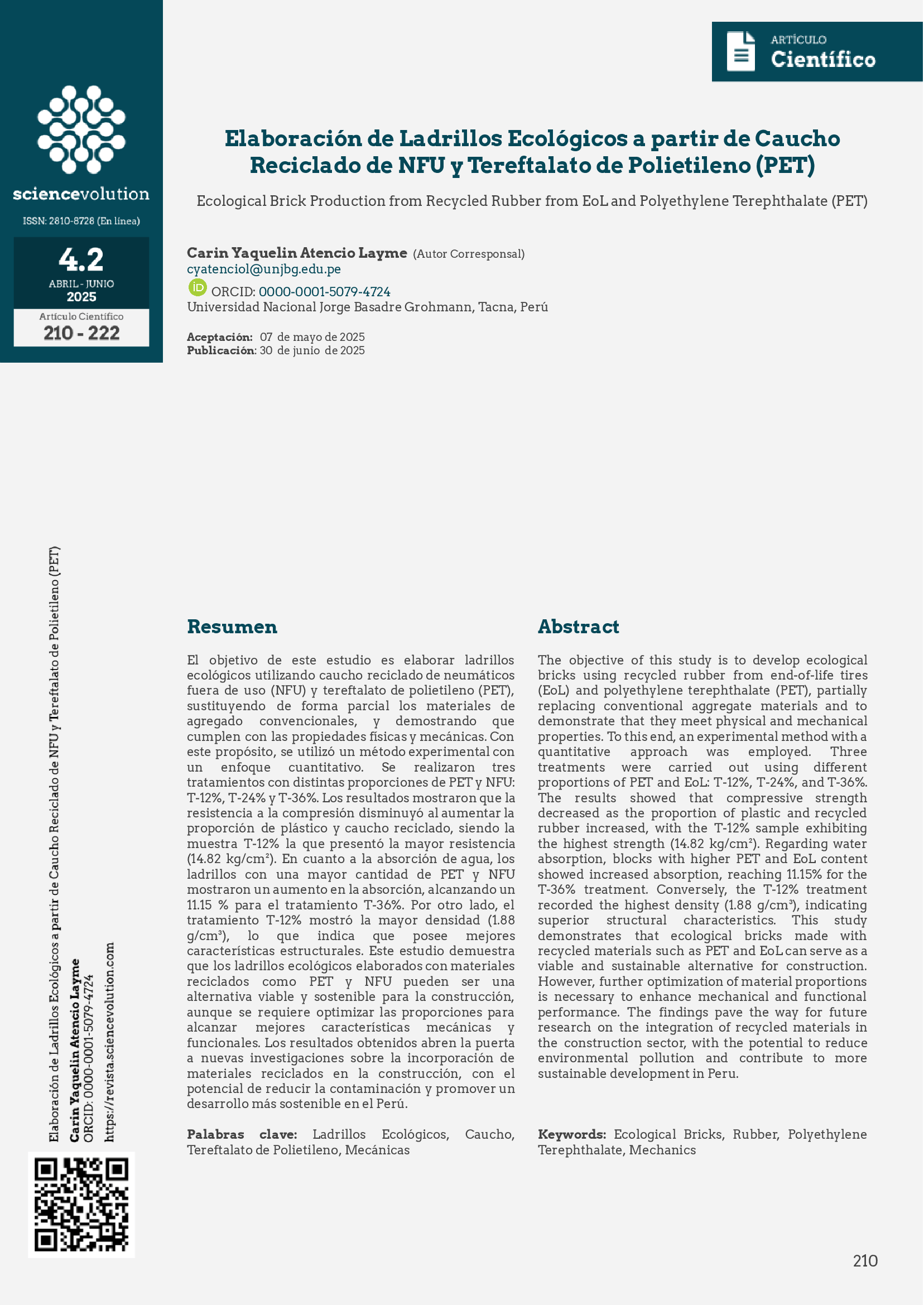Abstract
The objective of this study is to develop ecological bricks using recycled rubber from end-of-life tires (EoL) and polyethylene terephthalate (PET), partially replacing conventional aggregate materials and to demonstrate that they meet physical and mechanical properties. To this end, an experimental method with a quantitative approach was employed. Three treatments were carried out using different proportions of PET and EoL: T-12%, T-24%, and T-36%. The results showed that compressive strength decreased as the proportion of plastic and recycled rubber increased, with the T-12% sample exhibiting the highest strength (14.82 kg/cm²). Regarding water absorption, blocks with higher PET and EoL content showed increased absorption, reaching 11.15% for the T-36% treatment. Conversely, the T-12% treatment recorded the highest density (1.88 g/cm³), indicating superior structural characteristics. This study demonstrates that ecological bricks made with recycled materials such as PET and EoL can serve as a viable and sustainable alternative for construction. However, further optimization of material proportions is necessary to enhance mechanical and functional performance. The findings pave the way for future research on the integration of recycled materials in the construction sector, with the potential to reduce environmental pollution and contribute to more sustainable development in Peru.
References
Arriagada Urzúa, G., Avila Treviño, J. A., & Figueroa Meriño, J. (2024). Influencia en las Propiedades Mecánicas de Ladrillos Artesanales al Incorporar Caucho Triturado en la Fabricación. RIMI. Revista de Investigación Multidisciplinaria Iberoamericana, 2(4). https://doi.org/10.69850/rimi.vi4.112
Ashraf, N., El‑Monayeri, O. D., & Hassan, H. A. (2024). Lego‑like bricks manufacturing using recycled polyethylene (PE) and polyethylene terephthalate (PET) waste in Egypt. Sustainability, 16(19), 8567. https://doi.org/10.3390/su16198567
Chen, L., Yang, M., Chen, Z., Xie, Z., Huang, L., Osman, A. I., Farghali, M., Sandanayake, M., Liu, E., Ahn, Y. H., Al‑Muhtaseb, A. H., Rooney, D. W., & Yap, P.‑S. (2024). Conversion of waste into sustainable construction materials: A review of recent developments and prospects. Materials Today Sustainability, 27. https://doi.org/10.1016/j.mtsust.2024.100930
Contreras Moreto, J. A., Pérez Concha, M. A., & Pérez Concha, R. J. (2020). Evaluación de la resistencia a la compresión del adobe tradicional a los 20, 28 y 36 días de secado en la ciudad de Jaén – Cajamarca [Tesis de Ingeniería Civil, Universidad Nacional de Jaén]. Repositorio Institucional UNJ. http://repositorio.unj.edu.pe/handle/UNJ/264
Dabic‑Miletic, S., Simic, V., & Karagoz, S. (2021). End‑of‑life tire management: A critical review. Environmental Science and Pollution Research, 28(48), 68053–68070. https://doi.org/10.1007/s11356‑021‑16263‑6
Dhaka, V., Singh, S., Amith, A. G., Naik, T. S. S. K., Garg, S., Samuel, J., Kumar, M., Ramamurthy, P. C., & Singh, J. (2022). Occurrence, toxicity and remediation of polyethylene terephthalate plastics: A review. Environmental Chemistry Letters, 20(3), 1777–1800. https://doi.org/10.1007/s10311-021-01384-8
Gambin-Martínez, J. S., Bautista-Zapata, T. I., Torrado-Gómez, L. M., Guzmán, M. F. S., & Ruiz, D. D. P. (2023). Ecoladrillos: alternativa para aprovechamiento de arcilla y grano de caucho reciclado. Inquietud Empresarial, 23(1), 1–17. https://revistas.uptc.edu.co/index.php/inquietud_empresarial/article/view/15699
González, M. A., Rodríguez‑Sosa, M. A., Vásquez‑Bautista, Y. E., del Carmen‑Rosario, E., Durán‑Tiburcio, J. C., & Alarcón‑Elbal, P. M. (2020). Estudio de mosquitos (Diptera: Culicidae) que se desarrollan en neumáticos en República Dominicana: consideraciones sobre un problema acuciante. Biomédica. Revista del instituto Nacional de Salud, 40(3), 507–515. https://doi.org/10.7705/biomedica.5200
Han, B., Kumar, D., Pei, Y., Norton, M., Adams, S. D., Khoo, S. Y., & Kouzani, A. Z. (2024). Sustainable transformation of end‑of‑life tyres into value‑added products using thermochemical processes. Carbon Research, 3(73). https://doi.org/10.1007/s44246-024-00167-4
Instituto Nacional de Defensa de la Competencia y de la Protección de la Propiedad Intelectual. (2002). Norma Técnica Peruana NTP 399.604. Unidades de Albañilería. Métodos de muestreo y ensayo de unidades de albañilería de concreto. 1ª Edición. Comisión de Reglamentos Técnicos y Comerciales INDECOPI.
Jiménez Padilla, B. (2023). Técnicas básicas de mecánica de vehículos. MF0623_1 (2ª Ed.) Ic Editorial. La editorial de los Certificados de Profesionalidad y las Cualificaciones Profesionales, 398. https://www.iceditorial.com/oper-auxiliares-de-mant-en-electromecanica-de-vehiculos-tmvg0109/10817-tecnicas-basicas-de-mecanica-de-vehiculos-mf06231-2-ed-9788411842020.html
Lizarzaburu-Aguinaga, D., Farfan Gomez, J. D., Benites-Alfaro, E., Acosta Suasnabar, E., Lizarzaburu Aguinaga, M. G., y Orrego Cumpa, R. (2023). Recycling of Rubber and Polyethylene Terephthalate (PET) to Produce Ecological Bricks in Peru. Chemical Engineering Transactions , 101 , 199-204. https://doi.org/10.3303/CET23101034
Organización de las Naciones Unidas. (2015). Objetivos de desarrollo sostenible. https://www.un.org/sustainabledevelopment/es/objetivos-de-desarrollo-sostenible/
Paladhi, A. G., Vallinayagam, S., Rajendran, S., Rathinam, V., & Sharma, V. K. (2022). Chapter 30 - Microalgae: a promising tool for plastic degradation. Microbes and Microbial Biotechnology for Green Remediation, 575–587. https://doi.org/10.1016/B978-0-323-90452-0.00049-9
Programa de las Naciones Unidas para el Medio Ambiente. (2021). Informe de la ONU sobre contaminación por plásticos advierte sobre falsas soluciones y confirma la necesidad de una acción mundial urgente. UNEP. https://www.unep.org/es/noticias-y-reportajes/comunicado-de-prensa/informe-de-la-onu-sobre-contaminacion-por-plasticos/
Quispe Maquera, R. (2024). Elaboración de ladrillos ecológicos con plástico PET y papel reciclado, como alternativa para la construcción de viviendas en el distrito de Ilave - 2023 [Tesis de grado, Universidad Privada San Carlos]. Repositorio Alcira. http://repositorio.upsc.edu.pe/handle/UPSC/845
Ramírez Antezana, A. V. (2022). Reciclaje de tereftalato de polietileno. Revista de Investigación. Ingeniería y sus alcances , 6(14), 47–63. https://doi.org/10.33996/revistaingenieria.v6i14.90
Rebaza Paredes, W. C., & Quispe Basilio, M. D. (2023). Influencia de las cenizas de carbón de piedra en las propiedades físicomecánicas de un ladrillo ligero en el distrito de Quiruvilca – Santiago de Chuco [Tesis de pregrado, Universidad Nacional de Trujillo]. Repositorio UNT https://dspace.unitru.edu.pe/items/ea2dcb3d-ba3d-4358-9a8c-d6af90fe8c68
Ren, T., Zhan, H., Xu, H., Chen, L., Shen, W., Xu, Y., Zhao, D., Shao, Y., & Wang, Y. (2024). Recycling and high‑value utilization of polyethylene terephthalate wastes: A review. Environmental Research, 249, 118428. https://doi.org/10.1016/j.envres.2024.118428
Saud, H. M., Hassan, R., & Shabbir, U. (2025). Eco‑friendly bricks from plastic waste: A sustainable solution for construction and waste management. Kashf Journal of Multidisciplinary Research, 2(5), 56–74. https://doi.org/10.71146/kjmr444

This work is licensed under a Creative Commons Attribution-NonCommercial-NoDerivatives 4.0 International License.

